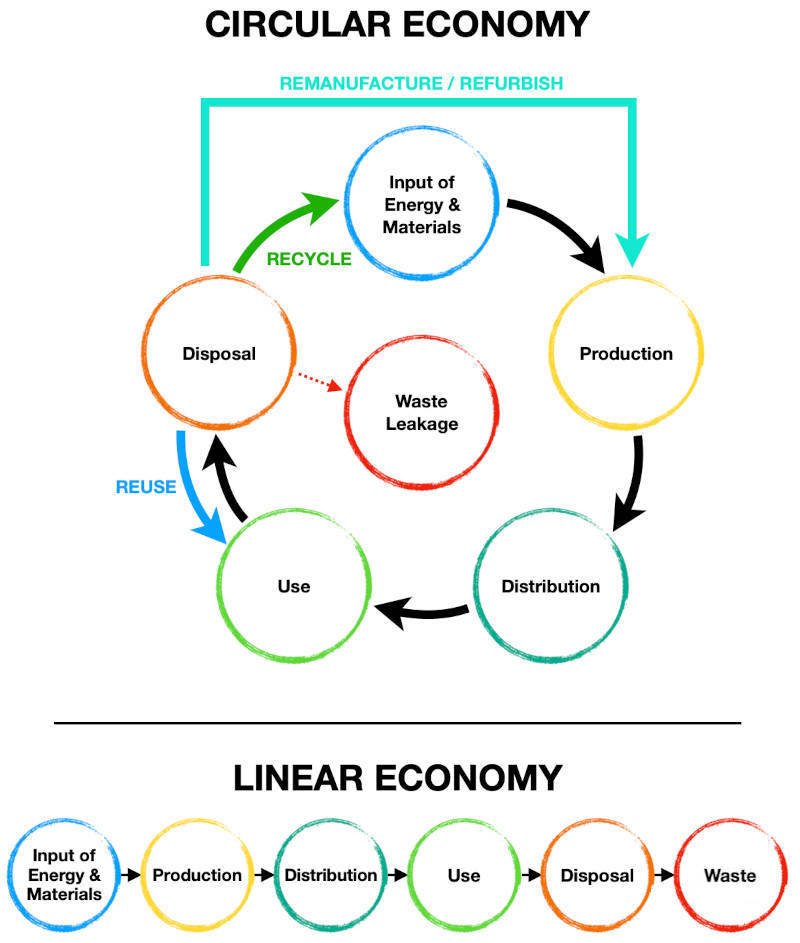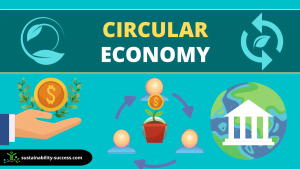In a circular economy, waste is minimized and resources are kept in use for as long as possible. This closed-loop system is designed to be more environmentally and socially responsible than the traditional linear economy, which relies on a linear model of take-make-dispose.
Key Takeaways
- Minimizes waste and maximizes resource use.
- It supports sustainability by reducing environmental impact and promoting efficiency.
- Challenges include mindset shifts and infrastructure development for reuse/recycling.
The graphic below illustrates the differences between the circular and linear economies:

As you can see, the production of some waste is still inevitable. However, the amount of waste would be much less in a circular model compared to the linear one.
The linear economic model is not sustainable in the long term, as it relies on a constant supply of new resources and creates mountains of waste.
The circular economy is instead restorative and regenerative by design and aims to gradually eliminate or reduce the use of toxic chemicals, energy from non-renewable sources, and materials from virgin sources.
The idea of this economic model has been around for decades, but it has gained more traction only in recent years as the focus shifted more and more towards sustainable development.
benefits for businesses
This circular economic framework offers a sustainable shift from the linear model, emphasizing the longevity and recycling of resources. Businesses adopting this approach can significantly cut waste, save on resource costs, and reduce environmental impact while creating value from extended product lifecycles and innovative service models.
Business Benefits include:
- Reduced long-term operational costs through efficient resource use.
- Enhanced customer engagement and loyalty with sustainable practices.
- Improved market differentiation by adopting green innovations.
- Increased revenue opportunities through new business models like product-as-a-service.
- Lowered regulatory and environmental compliance costs.
challenges
Transitioning to a circular economy presents significant challenges, primarily in altering the entrenched linear mindset of production and consumption. This shift demands a fundamental change in how we value and utilize resources, aiming for sustainability and efficiency in a world with growing demands.
Implementation challenges:
- Overcoming the deep-rooted linear consumption habits of individuals and industries.
- Developing new infrastructures for recycling and reuse instead of disposal.
- Encouraging businesses to design products with their entire lifecycle in mind.
- Addressing the financial and logistical hurdles in shifting to circular practices.
- Ensuring global cooperation, particularly in aiding developing countries to build the necessary frameworks.
the main components of a circular economy
There are three key components to a circular economy:
- Reducing waste and pollution
- Improving resource efficiency
- Creating economic value from waste and by-products
A circular economy is based on the principle of waste prevention, rather than waste management. By design, it reduces or eliminates the negative impacts of production and consumption, such as pollution and resource depletion.
Waste is seen as a valuable resource that can be used to create new products and generate new economic activity. This is in contrast to the traditional linear economy, where waste is seen as a disposal problem.
Circular thinking can be applied to any economic system, from manufacturing to agriculture to services. It is a holistic approach that considers the entire life cycle of a product or service, from raw materials to waste.
The goal is to eliminate waste and pollution, while still providing the same level of economic activity and consumer goods and services. This can be achieved through a variety of means, such as product design, material substitution, and waste reduction.
Circular Economy example
There are many examples of circularity in the economy, but one of the most notable is the way in which some companies are rethinking the way they use resources.
For example, instead of using virgin resources, some companies are using recycled materials to create new products. This reduces waste and helps to conserve resources.
In addition, some companies are redesigning products so that they can be reused or recycled instead of being thrown away. This helps to close the loop and keep resources in use for longer.
Now, let’s have a look at a case study!
Philips
Philips has been on a sustainability journey since the early 1990s. In 2012, Philips set a goal of 55% of total sales to be ‘green’ by 2025, and has redirected one third of its annual R&D budget towards green innovation.
As part of the company’s environmental responsibility, several years ago, Philips launched a circular economy pilot project in the Netherlands to test the feasibility of this approach. The pilot involved a number of product categories, like electric shavers, LED lamps, domestic appliances, and healthcare equipment.
The results of the pilot were positive, and Philips has since started to integrate the this new model for its products.
Philips recently made ambitious ESG (Environmental, Social, and Governance) commitments to embedding circular thinking in every step, from sustainable product design to customer service. The company’s stated goal is to generate 25% of its revenue from circular products, services, and solutions by 2025.
As of 2020, Philips already achieved important targets, in fact, the circular economic principles are already implemented for about 15% of their products.
The pursuit of the circular economic cycle is crucial to the sustainability strategy of Philips and it involves aspects such as:
- Sustainable circular design of products and services
- Circular business operations, with zero waste targets also for offices and facilities.
- Circular business models to help use the products as long as possible, including things such as refurbishments and repairs.
Conclusion
The circular economy extends beyond recycling, emphasizing the reuse and repair of products to maximize their lifespan, necessitating businesses to innovate in product design for longevity.
This approach aims to eliminate waste, utilizing materials in a continuous loop, thereby enhancing the value and reducing the environmental impact.
Businesses must strategize to close the loop in their operations, integrating recycled materials into new products and exploring novel uses for waste to create added value.
This shift not only benefits the environment but also offers economic opportunities, underlining the circular business model’s role in sustainable development.

